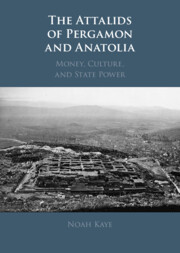Book contents
- The Attalids of Pergamon and Anatolia
- The Attalids of Pergamon and Anatolia
- Copyright page
- Dedication
- Contents
- Figures
- Graphs
- Maps
- Acknowledgments
- List of Abbreviations
- Introduction
- 1 Eating with the Tax Collectors
- 2 The Skeleton of the State
- 3 The King’s Money
- 4 Cities and Other Civic Organisms
- 5 Hastening to the Gymnasium
- 6 Pergamene Panhellenism
- Conclusion
- Appendix of Epigraphical Documents
- Bibliography
- Index Locorum
- Subject Index
Introduction
- The Attalids of Pergamon and Anatolia
- The Attalids of Pergamon and Anatolia
- Copyright page
- Dedication
- Contents
- Figures
- Graphs
- Maps
- Acknowledgments
- List of Abbreviations
- Introduction
- 1 Eating with the Tax Collectors
- 2 The Skeleton of the State
- 3 The King’s Money
- 4 Cities and Other Civic Organisms
- 5 Hastening to the Gymnasium
- 6 Pergamene Panhellenism
- Conclusion
- Appendix of Epigraphical Documents
- Bibliography
- Index Locorum
- Subject Index
Summary
In the sunny, austere central hall of the Pergamon Museum in Berlin, wrapping around the room’s walls like a serpent, then rising halfway to the ceiling on marble steps, stands a strident, if also fragmentary statement of empire. It is an unfinished wedding cake of a building. Tourists recline languidly on its ascent, like guests with nowhere to sit. The room is just too small; it is overtaken by the object on display: the Great Altar of Pergamon. The Altar, with its two sculptural friezes, the outer depicting the Battle of Gods and Giants, the inner, the tale of Telephos, son of Herakles and heroic ancestor of the Attalid dynasty, was discovered in 1871, the year in which the Second German Empire was born. The engineer Karl Humann stumbled upon the marble fragments while building infrastructure for Ottoman Turkey, making the Altar as we know it a pure product of German, French, and British competition for influence in the Middle East. Today, Turkey has regained confidence, and officials from the Prussian Cultural Heritage Foundation expect Ankara to ask for it back.
- Type
- Chapter
- Information
- The Attalids of Pergamon and AnatoliaMoney, Culture, and State Power, pp. 1 - 33Publisher: Cambridge University PressPrint publication year: 2022

